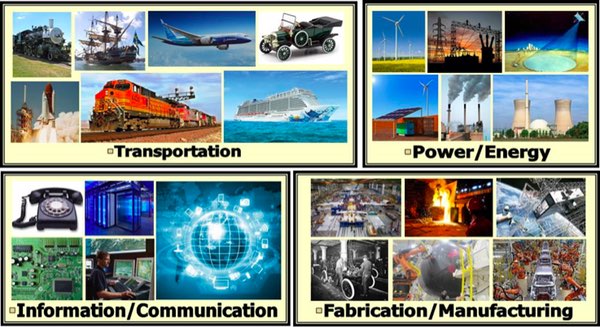Technology shocks are felt around the worldby Steve Hoeser
|
| When we enter the realm of foundational technology changes, we enter into the potential for truly dramatic alterations in human culture and the activation of historic business growth. |
A shock technology can be simple or grand in its nature and effect. In their simplest form, there are substitution technologies that create subtle changes in the current socio-economic behavior of a culture. An excellent example is the product known as Velcro. This new way of fastening things together has displaced (but not eliminated) many applications of shoestrings, mechanical snaps, and zippers.
Yet these simple types of substitution technologies only scratch the surface of how much grander technology shocks can activate cultural change and economic growth cycles. When we enter the realm of foundational technology changes, we enter into the potential for truly dramatic alterations in human culture and the activation of historic business growth. New foundational technologies can also instigate changes the power position of nations.
Foundational technologies can be placed into four categories, as shown in Figure 1 above. These categories are: transportation, power/energy, information/communication, and industrial fabrication/manufacturing.
Examples of technology-induced shocks can be traced over the course of human history. They have been so important to fundamental changes to humanity that they have caused historians to name entire ages after them. When humanity learned methods to shape rocks into tools, historians dubbed it the Stone Age. When humans learned how to process copper and then create the bronze alloy, they became known as the Copper and Bronze Ages. The later discovery of iron smelting and then the development of the steel Bessemer blast furnace process ushered in the Ages of Iron and Steel.
Harnessing the power of water with the water wheel technology and then energy of steam-fired engines sparked the Industrial Revolution. Technologies to produce and distribute electric power have induced exponential cycles of industrial-driven economic growth, product innovations, as well as consumer comfort and conveniences.
The development of new industrial fabrication and manufacturing methods, including the assembly line, robotics, and now 3-D manufacturing, has induced central shifts and opportunities for entirely new businesses. The discovery of plastics and, more recently, composites provided new materials to enhance the performance of existing products and the creation of new ones. These demands in turn helped fuel expanding industrial growth cycles.
| Through their mere existence, new foundational technologies influence and can combine with other technologies to create unforeseen affects that often multiply their impacts even beyond the imagination of science fiction authors. |
Introduction of transportation technologies have induced shifts in human interactions and also stimulated migrations. The invention of the wheel and plow, coupled with the domestication of the horse, help explode populations and shifted political borders. Exploiting steam and later diesel to power railroad engines stimulated the creation of transportation business empires. The evolution of ships from the simple logs to the East Indian merchant ships to today’s giant ships has fostered global trade networks. In the last century, advances in flight from the Wright flyer to today’s airliners and emerging reusable rockets have not only shrunk travel times and costs to the masses but is opening access to a new space frontier.
Advances in technologies to communicate information continue at a remarkable pace. From semaphores on mountains through the telegraph, radio, telephones (both wired and wireless) an on to the mega-impact of the Internet, these foundational communication technologies have ushered in the Information Age. Coupled with computers and our portable information-exchange devices, they have opened a new cyber-frontier, establishing new intercultural dominions and expansive prosperity.
Yet it is not simply the introduction of the foundational technology but also the interactive dynamics of how these new technologies are used that creates often unanticipated and remarkable global changes. Through their mere existence, new foundational technologies influence and can combine with other technologies to create unforeseen affects that often multiply their impacts even beyond the imagination of science fiction authors.
In 1978, the BBC aired a series called Connections hosted by James Burke that attempted to show historic traces of such technologic interactive dynamics.4 This series explored the various paths of how technology-induced change happens and the social effects of these changes on Western society. In some cases, the series showed how several technologies, when combined with other technology innovations, produces history-altering system capability changes. Just one example is how the Dutch East India Company leveraged advanced sail bloc-and-tackle designs to reduce the manpower to operate their ships. The lower number of sailors allowed hull designs to accommodate more cargo. Then, by leveraging the new industrial saw mills, ship-building costs were slashed,5 thus creating a global trade giant.
To further illustrate this effect, let’s use this predictive perspective and look at one possible foundational shock technology introduction scenario. More specifically, how the introduction this technology could stimulate dynamic and globally interactive effects and catalyze growth in the space frontier.
Compared to the rest of the world, the prices paid by the United States and most industrial nations for electric energy remain a small fraction for the consumer. This relatively cheap electricity is the result of a network of power production plants along with a robust power distribution network. Nations without such infrastructures are at a distinct disadvantage and crave electric power as a means to help fuel their socio-economic growth and expansion.
It is for these and other reasons that the world’s hunger for electric power and demands are projected to continue to grow rapidly into the future. Regardless of your selected scenario, yearly electric power consumption estimates indicate an ever-increasing demand for global energy. The total global electric power usage in 2012 was estimated to be about 21 terawatt-hours (tWh) or 21,000 billion kilowatt-hours.6 One projection of future demands indicates that from 2030 to 2040, electric power needs will increase to 22 tWh, then 40 tWh in 2060–70 and to 48 tWh in the 2090–2100 timeframes.7 Other predictions assume an even higher demand, as shown in the first graph in Figure 2.
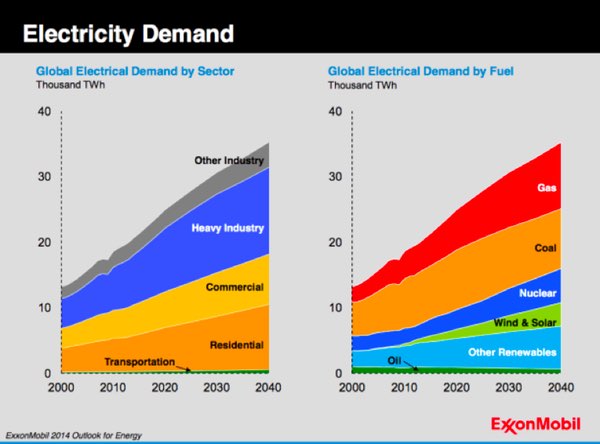 Figure 2: Global electrical power demand and source projections. (credit:Exxon Mobil) |
Throughout this projection, the primary means to produce electric power induce increasing negative global impacting factors, as the other graph of Figure 2 shows. These include the environmental consequences of the exhaust products of burning power plant fuels like oil and coal. The negative impacts from these plants are especially profound from those national regimes that are less than environmentally conscious.
| There are a number of groups working on plasma thruster technologies that, when combined with a compact polywell fusion reactor, could create a truly interplanetary fusion drive for spaceships. |
For those countries opting to use fission nuclear power reactors, the impacts are more far reaching. These include the production of horrifically toxic nuclear waste that is a nightmarish hazard. Plutonium-239, which is an irradiated nuclear fuel, has a half-life of 24,400 years. It is considered dangerous to biologic organisms for a quarter-million years, or 12,000 human generations. As it decays, uranium-235 is generated. This radioactive isotope has a half-life of 710,000 years.8
These conditions have begun a laborious development trend toward alternative electric power production. Current developments include wind, solar, and hydropower production. Though promising most of these methods remain less than efficient and currently constitute a small fraction of the world’s electric power production capacity. Most projections, like the figure above, anticipate a small but steady growth for these alternatives.
New and innovative alternatives have been proposed include moving power production off-earth to solar power satellites (SPS). These SPS systems would beam energy to anywhere it is needed on earth. One of the recent of these innovative SPS concepts is the ALPHA Solar Power Satellite.9 But like past SPS concepts, they do not become competitive to Earth-based power production systems at current high launch costs.
But what would happen if a viable compact form of clean and safe fusion power production technology were to be introduced? Naysayers will be quick to point out that fusion technology development efforts have been going on for almost 50 years and have yet to produce meaningful results. Most of these fusion options are massive in scale and appear no closer to the “break-even” or even net power production (power produced equal to or better than the power needed to run the fusion reactor) Holy Grail than in the past. It’s estimated the US government alone has spent more than $21 billion in the last 50 years in the pursuit of a viable nuclear fusion reactor capability.10 This does not even include investments of other countries or private investors such as Jeff Bezos, Peter Thiel, and Paul Allen on newer approaches.11
Yet there is a fusion power production technology that has been simmering quietly in the background on a trickle of funding that could create a foundational technology shock. This is a compact fusion power production technology that would be safe enough that it could not only be used in new small electric power plants though out the world, but could also be the basis of a reactor to power oceangoing ships. It is little wonder that the Navy has been quietly investing small amounts of funding in its development for a number of years.
This fusion technology is created by multiple specially shaped strong magnetic fields and is referred to as a polywell fusion, as illustrated in Figure 3. The basic polywell configuration concept was proposed and patented by the noted physicist Dr. Robert Bussard in 1989 (yes, this is the same fellow that conceptualized the Bussard Collectors and interstellar hydrogen ramjet starship concept.) Using a geometrically positioned set of magnets, multiple overlapping deep spherical “electro-potential” wells are created. Bussard used tell me and others that the ultimate reactor magnet shape would look like a whiffle-ball.
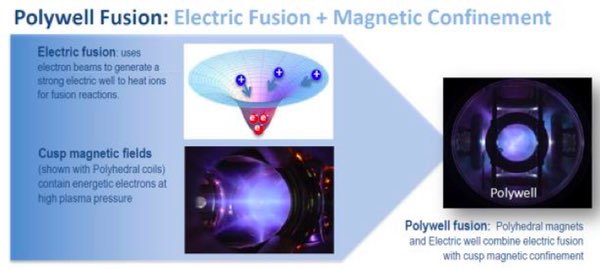 Figure 3: Basic Polywell Fusion Technology Operation. (credit: Energy Matter Conversion Corp. - EMC2) |
The polywell fusion system basic operating mode uses magnetic wells, into which ions are directly injected. These ions travel from the edge inward to the bottom of the potential well produced by each encircling magnet. This results in the formation of a region in the center of the device where high-energy ions converge and collide at extreme velocity. The result is a number of head-on collisions that meet with sufficient velocity to fuse and release energy. So promising have been recent developments that Lockheed’s Skunk-Works has begun their own development work on a design for a variant of this compact fusion reactor.12
As a new foundational power technology, polywell fusion could provide a safe and economical alternative to meeting growing global power needs in multiple applications, as shown in Figure 4. It could foster the transition away from fossil fuels, which we know negatively impact our environment. Variations of this power technology could also be added to existing nuclear power plants to product additional electricity and, using a process called transmutation, could transform nuclear waste into more manageable products for on-site disposal.13 Its small size could make polywell fusion reactor powered desalinization plants economically practical throughout the world.
| With economic low Earth orbit access, fusion reactor technology can be even more fully exploited to create the stuff of science fiction of accelerated expansion of the final space frontier. |
There are a number of groups working on plasma thruster technologies that, when combined with a compact polywell fusion reactor, could create a truly interplanetary fusion drive for spaceships. Such a constant high-thrust propulsion system could open the entire solar system to rapid transit. Fast human Mars missions of only 90 to 100 days with a payload capacity of 2 to 14 percent become possible. This faster trip and reduced payload further reduces space vehicle mass by factor of four over conventional chemical rockets.14,15,16
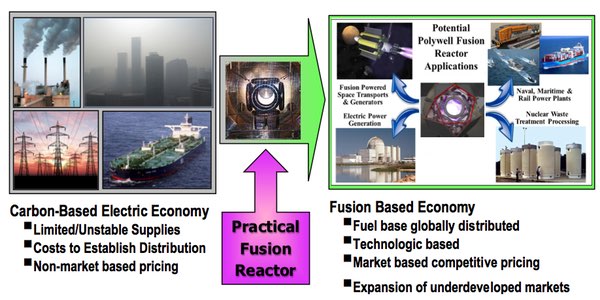 Figure 4: Foundational impacts stimulated by the introduction of foundational compact fusion power technology. (credit: NASA, U.S. Navy, Kansas City Power & Light, Westar Energy, Premiere Energy Auctions, Reuters photog-Jason Lee, EMC2 Inc., USA Today, Marrekie, Nuclear Regulatory Commission) |
In parallel development are the commercial activities that are now combining technologies to development low-cost, safe, and reliable reusable Earth-to-orbit transport services. This critical space transport leg is itself a shock technology that will finally allow us to secure our low Earth orbit frontier beachhead. Both Blue Origin and SpaceX apparently see this impact and are in hot pursuit of such reusable launch vehicle (RLV) capabilities.
With economic low Earth orbit access, fusion reactor technology can be even more fully exploited to create the stuff of science fiction of accelerated expansion of the final space frontier, as shown in figure 5. Coupled to advanced fusion drive space propulsion engines currently on the drawing boards and in labs, a network of solar system space transports would support an exponential growth in humankind’s solar system exploration. Using deep space fusion-powered mineral processing plants, the vast resources of the asteroid belt between Mars and Jupiter could foster moving many heavy industries into space. These industries, in turn, would create job opportunities that stimulate the creation of supporting cultural and service space infrastructure in ever larger space colonies of a new space age.17,18
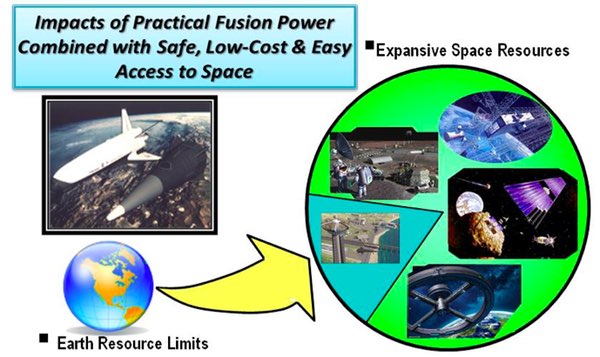 Figure 5: Impacts of combined foundational shock technologies in opening the space frontier. (Credit pictures: NASA, National Space Society, Space Studies Institute, Department of Energy, Dream Wall-Papers) |
Exploiting modern systems dynamic methods within the context of buffered introduction of foundational technologies, we have the opportunity to make more informed technology investment choices and create effective new national strategies of technology.20 With such understanding of foundational shock technologies, our nation can also more effectively select the policies and support programs that can lead the world to greater global economic prosperity and security.
Endnotes
- Kydland, Finn E., and Prescott, Edward C. 1982. Time to build and aggregate fluctuations. Econometrica 50 (November): 1345-70.
- Prescott, Edward C. 1986a. Theory ahead of business cycle measurement. Federal Reserve Bank of Minneapolis Quarterly Review 10 (Fall): 9-22.
- Jay W. Forrester, Counter Intuitive Behavior of Social Systems, Technology, Alumni Association of the Massachusetts Institute of Technology, January, 1971.
- This series also had reincarnations during season 2 in 1993 and in season 3 in 1996.
- Dutch East India Company Shipbuilding: The Archaeological Study of Batavia and Other Seventeenth-Century VOC Ships, Ed Rachal Foundation Nautical Archaeology Series.
- International Energy Agency.
- The Case for Space Solar Power, John C. Mankins, Virginia Edition Publishing, 2014.
- Source: U.S. Nuclear Regulatory Commision.
- The Case for Space Solar Power, John C. Mankins, Virginia Edition Publishing, LLC, 2014.
- Space‐Based Solar Power As an Opportunity for Strategic Security, Phase 0 Architecture Feasibility Study, Report to the Director, National Security Space Office Interim Assessment, 10 October 2007.
- http://www.inc.com/will-yakowicz/bezos-thiel-fund-nuclear-fusion-startups.html
- http://www.lockheedmartin.com/us/products/compact-fusion.html
- Transmutation Processing of Fission Product Nuclear Wastes, Robert Bussard, EMC2-1203-90 paper.
- Rapid Mars Transits With Exhaust-Modulated Plasma Propulsion, Franklin R. Chang Díaz, Michael M. Hsu, Ellen Braden, Ivan Johnson ,Tien Fang Yang, NASA Technical Paper 3539, March 1995.
- Advanced Plasma Thruster (APT); High Specific Impulse, High Thrust & High Energy Conversion Efficiency, Dr. Dah Yu Cheng, briefing - August, 1988.
- FUSION PROPULSION Z-PINCH ENGINE CONCEPT, J. Miernik, G. Statham, ERC Inc; L. Fabisinski, ISS Inc; C. D. Maples, Qualis Corp. Jacobs ESTS Group, R. Adams, T. Polsgrove, S. Fincher, NASA MSFC, J. Cassibry, R. Cortez, M. Turner Propulsion Research Center, University of Alabama Huntsville, T. Percy, SAIC Advanced Concepts Office, Marshall Space Flight Center, Huntsville, Alabama, released for unlimited distribution in 2012.
- The High Frontier, Third Edition by Gerard K. O’Neill (2000) (ISBN: 0-9622379-0-6)
- Space Settlements: A Design Study, 1977, NASA SP-413
